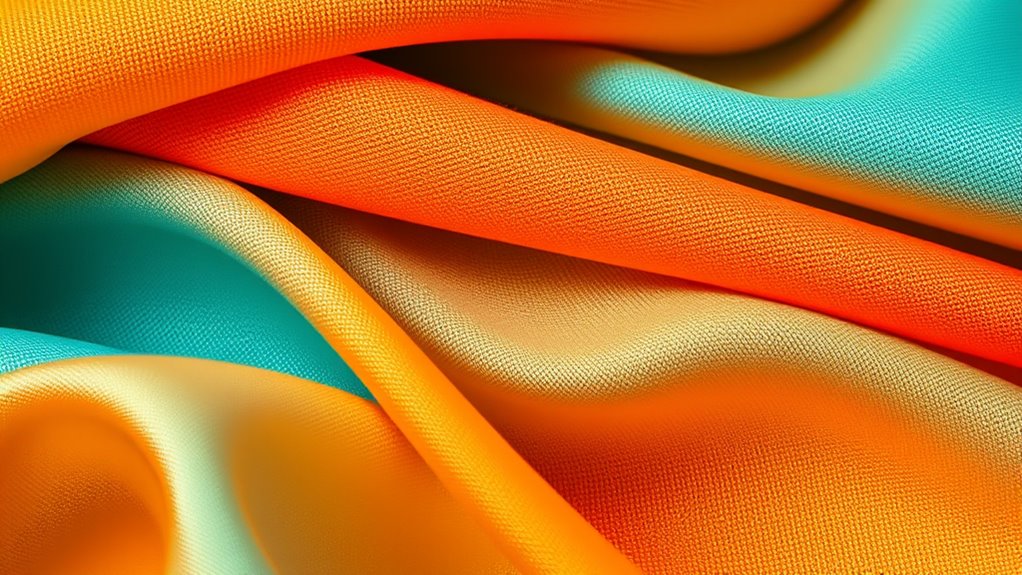To create compelling color harmony, rely on physics principles like selecting complementary hues that sit opposite on the color wheel for high contrast and emotional impact. Use analogous colors nearby for harmony, and consider temperature—warm tones evoke energy, cool tones foster calm. Smooth gradient transitions improve visual flow, while understanding brightness, contrast, and saturation influences perception and focus. Keep these scientifically backed hacks in mind, and you’ll open even more tips as you explore further.
Key Takeaways
- Use complementary color pairs on the wheel to create high contrast and visual interest rooted in physics of wavelength detection.
- Employ analogous colors for harmonious palettes that transition smoothly, enhancing unity and balance in designs.
- Adjust color temperature—warm for energy, cool for calm—to evoke specific emotional responses aligned with color psychology.
- Implement seamless gradients to guide the viewer’s eye naturally, creating depth and emotional flow based on color blending principles.
- Consider light reflection and surface properties, as they influence perceived hue, saturation, and contrast, ensuring accurate color harmony.
The Science Behind Complementary Colors

Have you ever noticed how certain color pairs instantly stand out when placed together? That’s the power of complementary colors, rooted in the science of color theory. When you pair colors opposite each other on the color wheel, they create high contrast and visual interest. This effect is grounded in physics, as our eyes detect these contrasting wavelengths, making the combination pop. Understanding color psychology helps explain why these pairings evoke strong emotions—red and green can symbolize balance or tension, depending on context. Cultural color meanings also influence perception; for example, red might signify luck in China but danger in Western cultures. Recognizing these aspects helps you craft designs that are not only visually striking but also culturally resonant. Additionally, visual perception plays a crucial role in how we interpret these color contrasts, enhancing their impact in design.
Why Analogous Colors Create Harmony

Because analogous colors sit next to each other on the color wheel, they naturally create a sense of unity and visual flow. This color proximity fosters an intuitive harmony that’s easy on the eyes. When you use an analogous pairing, the colors blend seamlessly, making your design feel cohesive and balanced. These combinations evoke calmness and warmth, perfect for creating inviting spaces or gentle visuals. Their close relationship ensures that no color dominates, maintaining visual harmony. To capitalize on this, choose a dominant hue and accent it with neighboring shades. Keep in mind that the harmony depends on subtle differences, so avoid stark contrasts. Understanding color relationships helps in selecting effective analogous color schemes that deliver a unified aesthetic. This approach simplifies color selection while delivering a pleasing, balanced look.
Analogous colors create seamless, calming visual harmony through smooth transitions and balanced, inviting palettes.
- Smooth transitions between shades
- Consistent visual rhythm
- Enhanced color balance
- Subtle, calming effects
The Role of Color Temperature in Design
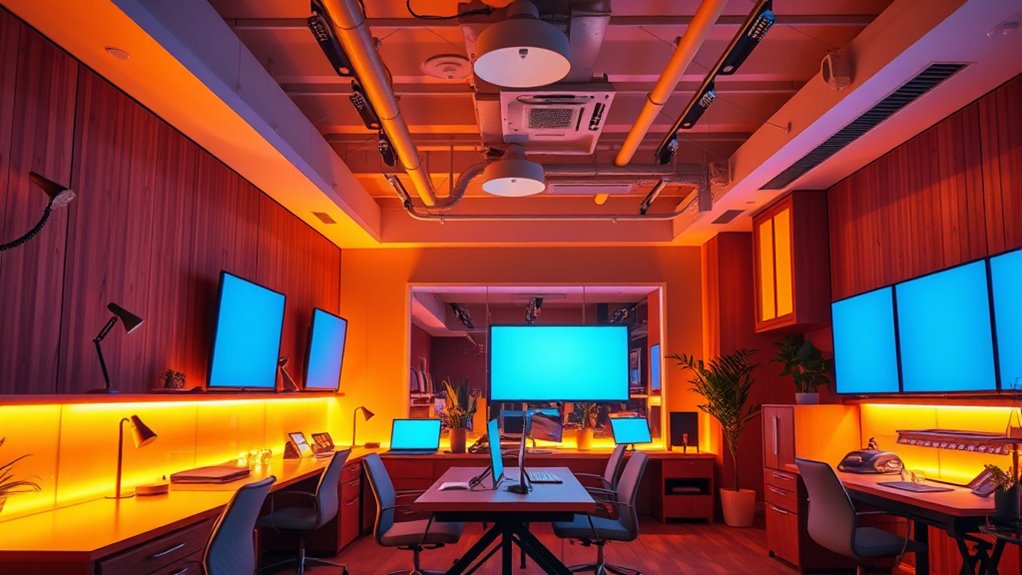
Warm tones can make your design feel inviting and energetic, while cool tones create a calm and professional atmosphere. The temperature of colors influences how viewers emotionally respond to your work. Understanding this can help you choose the right palette to evoke the desired mood effectively. For example, incorporating Nike Tech materials can enhance both style and performance, aligning with the emotional tone you aim to convey.
Warm vs. Cool Tones
Color temperature plays an essential role in setting the mood and tone of your design, with warm and cool tones conveying very different feelings. Warm tones like reds and oranges evoke energy, comfort, and intimacy through color psychology, making spaces feel inviting. Cool tones such as blues and greens promote calmness, professionalism, and trust, often influenced by cultural associations like serenity or stability. Choosing between warm and cool tones depends on the message you want to communicate. Warm colors can stimulate excitement, while cool colors tend to soothe. Understanding these differences helps you craft a balanced palette that aligns with your brand or project goals. Additionally, modern toilet designs often incorporate color harmony principles to create aesthetically pleasing bathrooms that enhance the user experience.
Emotional Impact of Temperature
The emotional response elicited by a color’s temperature can substantially influence how your audience perceives your design. Color psychology shows that warm colors like reds and oranges evoke energy, passion, and urgency, while cool colors like blues and greens promote calmness, trust, and serenity. Your understanding of temperature perception helps you craft designs that align with your intended emotional impact. For example, using warm tones can energize viewers and create excitement, making them feel more engaged. Conversely, cool tones foster relaxation and trust, ideal for professional or healthcare settings. Recognizing how color temperature influences emotion allows you to select hues that reinforce your message, creating a powerful, subconscious connection with your audience. Mastering this aspect of color psychology enhances your ability to communicate effectively through your designs. Additionally, understanding Glycolic Acid Benefits can improve your skincare routine by promoting skin clarity and texture, which can complement a well-designed personal or brand image.
How Gradient Transitions Influence Perception
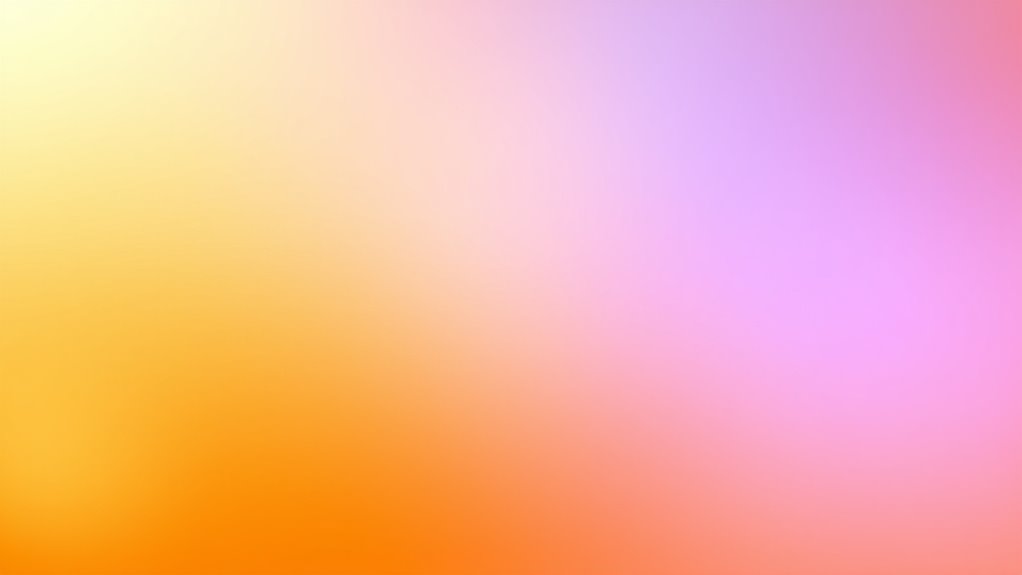
Smooth gradient progressions guide the eye naturally, creating a seamless visual flow that keeps viewers engaged. The way colors blend can evoke specific emotions, making your design feel more dynamic or calming. Additionally, perceived depth shifts with gradient sharpness, influencing how layered or flat your composition appears. Incorporating color harmony techniques can further enhance the visual impact of your gradients by ensuring a balanced and aesthetically pleasing palette.
Smoothness Affects Visual Flow
When gradient shifts are seamless, your eyes naturally follow the flow of colors, creating a sense of movement and harmony. Smooth progressions guide viewers smoothly across a design, enhancing visual flow. This influences how you perceive the message, leveraging color psychology to evoke feelings and reactions. Additionally, careful gradient planning improves color accessibility, ensuring all users can distinguish and interpret the colors effectively. Proper gradient design can also prevent issues related to visual fatigue, making interfaces more comfortable to view over extended periods.
- Seamless gradients promote natural eye movement
- Enhance emotional responses through fluid color shifts
- Improve accessibility for users with color vision deficiencies
- Create cohesive, professional-looking designs
Mastering smooth gradients helps you craft designs that feel intuitive and engaging, making your visual communication more effective. The subtlety of transition influences perception, reinforcing the overall harmony of your color palette.
Color Blends Impact Emotions
Seamless gradient shifts do more than guide the eye—they also shape emotional responses by subtly influencing perception. Color psychology reveals how smooth transitions evoke moods; warm gradients can energize, while cool blends promote calmness. Cultural color meanings also play a role, as certain colors evoke specific feelings across different societies. Recognizing these patterns helps you craft designs that resonate emotionally. Consider this table to understand how color blends influence perception:
| Color Transition | Emotional Impact | Cultural Meaning |
|---|---|---|
| Red to Orange | Excitement, passion | Courage, vitality |
| Blue to Green | Calm, tranquility | Growth, harmony |
| Yellow to Gold | Optimism, happiness | Wealth, prosperity |
| Purple to Pink | Creativity, compassion | Royalty, love |
| Black to Gray | Sophistication, neutrality | Mourning, balance |
Additionally, understanding color transitions can enhance the overall harmony of your design by aligning visual flow with emotional intent.
Perceived Depth Changes
Gradient shifts considerably influence how you perceive depth in a design. Smooth progressions can create a sense of visual layering, making elements appear closer or farther away. By manipulating gradient direction and intensity, you guide the viewer’s eye and enhance the perceived depth. Incorporating natural materials into gradient design can further enhance realism and depth perception. These techniques leverage physics principles to craft visual cues, reinforcing perceived depth without extra elements. When you use gradient progressions thoughtfully, you enhance spatial understanding and add a dynamic, immersive quality to your design.
The Physics of Brightness and Contrast

Ever wondered how the brightness and contrast in an image influence your perception of colors? It all comes down to the physics of light diffusion and how your eyes interpret varying light levels. Brightness affects how vivid or dull a color appears, with higher brightness making colors seem more intense. Contrast, on the other hand, enhances the difference between light and dark areas, sharpening color boundaries. When light diffuses evenly across a surface, it creates a consistent color perception, making hues appear true to life. Conversely, uneven diffusion can distort color perception, causing some shades to seem faded or exaggerated. By understanding how light interacts with surfaces and how contrast amplifies these effects, you can manipulate images to create more compelling, harmonious color schemes.
Understanding Color Saturation and Its Impact
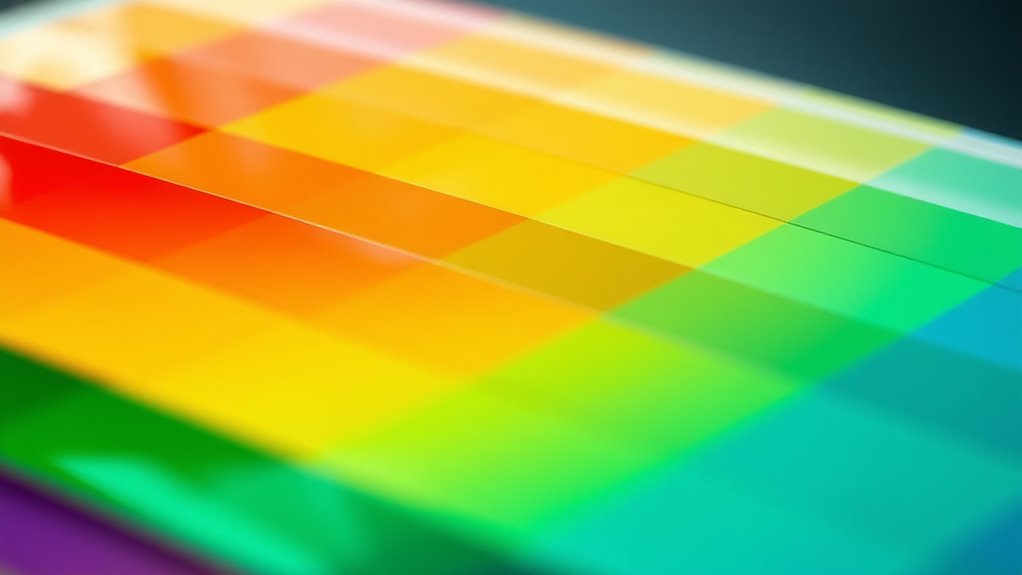
Understanding color saturation is essential because it determines how vivid or muted a color appears in an image. High saturation enhances visual vibrancy, making colors pop and capture attention, while low saturation creates a subdued, calming effect. When you manipulate color saturation, you influence the emotional response and overall harmony of your design. Saturation levels affect how viewers perceive depth and focus, guiding their eye to key elements. To better grasp this, consider these points:
Adjusting color saturation influences emotional impact and visual clarity in your designs.
- Bright, highly saturated colors evoke energy and excitement.
- Muted, low-saturation tones promote subtlety and sophistication.
- Adjusting saturation can create contrast or harmony within a palette.
- Over-saturation risks overwhelming the viewer, reducing clarity.
- Being aware of color psychology helps you choose saturation levels that align with your intended message.
Mastering color saturation helps you craft compositions that are both compelling and balanced.
The Effect of Color Schemes on Visual Hierarchy

Color schemes play an essential role in establishing a clear visual hierarchy within your design. By understanding color psychology, you can highlight important elements and guide viewers’ attention naturally. Bright, contrasting colors draw focus to key messages or calls to action, making them stand out. Meanwhile, muted or harmonious hues recede into the background, creating a sense of depth and supporting less critical content. Cultural color meanings also influence how viewers interpret your palette; for example, red might evoke urgency or excitement in one culture, while symbolizing luck in another. Using these insights, you can craft color schemes that not only improve readability but also communicate your intended message effectively, ensuring your design directs viewers’ eyes precisely where you want them to go.
Light Reflection and Its Effect on Color Choices

Light reflection profoundly influences how colors appear in your design, as the way surfaces reflect light can alter their perceived hue, brightness, and saturation. When light hits a surface, some of it is absorbed, affecting how vivid or muted the color seems. Reflection also causes color diffusion, spreading light across neighboring areas and softening edges. These processes impact your color choices, especially in spaces with varying lighting conditions. Understanding how light interacts with surfaces helps you predict how colors will look under different circumstances. By considering light absorption and diffusion, you can select colors that maintain their harmony and clarity regardless of lighting. This awareness allows you to create balanced designs that look intentional and cohesive.
- Surfaces with high light absorption appear darker or more muted.
- Light diffusion softens color boundaries and enhances harmony.
- Reflective surfaces amplify brightness and saturation.
- Varying light reflection can shift perceived hue and saturation.
Utilizing Color Wheel Theory for Effective Combinations
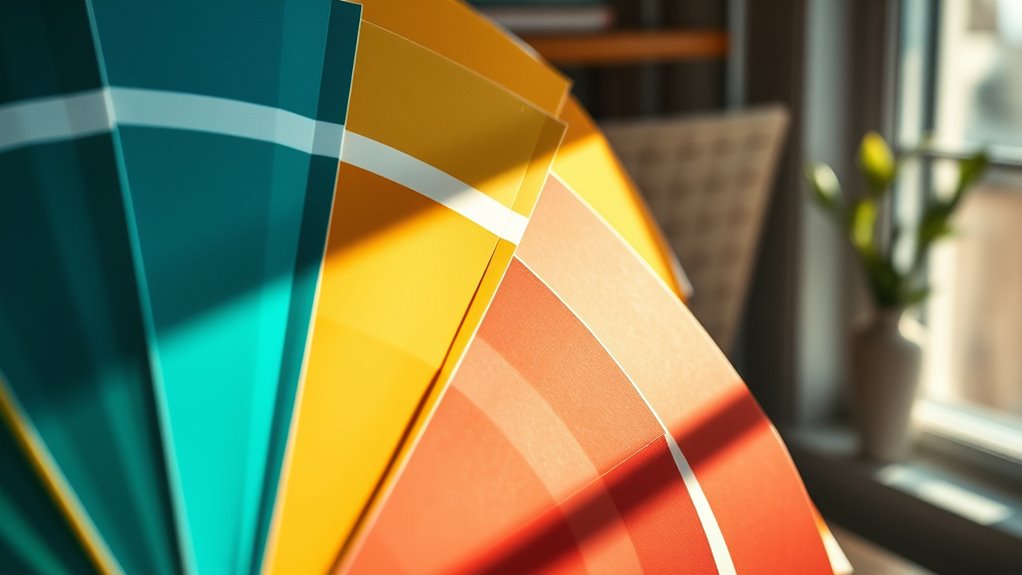
The way surfaces reflect light directly impacts how colors are perceived, influencing their harmony and contrast. When you utilize the color wheel theory, you can create balanced and visually appealing combinations by understanding color relationships. Complementary colors, which sit opposite each other on the wheel, evoke strong contrast and energy, while analogous colors, next to each other, foster harmony. Incorporate insights from color psychology to choose hues that resonate emotionally, and consider cultural color meanings to guarantee your palette communicates the intended message across diverse audiences. By applying these principles, you enhance your design’s effectiveness, making sure your color choices align with both emotional impact and cultural context. Mastering the color wheel helps you craft compelling visuals that captivate and connect.
Frequently Asked Questions
How Does Human Eye Perception Influence Color Harmony Choices?
Your perception biases and visual acuity greatly influence your color harmony choices. When you view colors, your brain interprets hues through these biases, making some combinations more appealing or harmonious. For example, your eyes might perceive complementary colors as more vibrant due to contrast sensitivity. Understanding how perception works helps you select color schemes that look balanced and pleasing, leveraging your natural visual tendencies for more effective design.
Can Color Harmony Principles Be Applied Across Different Cultural Contexts?
You can apply color harmony principles across different cultural contexts by understanding cultural symbolism and regional preferences. While basic color relationships work universally, the meaning attached to specific colors varies. For example, red symbolizes luck in some cultures and danger in others. By respecting these differences, you tailor your designs to resonate emotionally, creating harmony that aligns with cultural significance and regional tastes, ensuring your work connects effectively worldwide.
What Role Does Emotional Response Play in Color Pairing Decisions?
You might wonder if emotional response influences your color pairing decisions. The truth is, emotional triggers profoundly impact how colors are perceived and combined. The mood influence of certain hues can evoke feelings like calmness or excitement, guiding your choices. By understanding these emotional cues, you can craft more compelling designs that resonate deeply with viewers, making color pairing a powerful tool for creating meaningful visual experiences.
Are There Universal Color Combinations That Work Universally in Design?
You might wonder if universal color combinations work across all designs. While some pairs, like blue and white, leverage color psychology to evoke calmness and trust, the effectiveness depends on color temperature. Warm tones create energy, while cool tones promote relaxation. So, yes, certain combinations are broadly effective, but always consider your audience and context to guarantee your color choices resonate universally.
How Do Environmental Factors Affect Optimal Color Scheme Selection?
Environmental factors like lighting conditions and ambient temperature greatly influence your choice of color schemes. Bright lighting can make colors pop, so you might opt for bolder hues, while dimmer environments call for softer shades. Warm temperatures can enhance earthy tones, whereas cooler settings suit blues and greens. Adjusting your palette based on these factors ensures your design remains visually appealing and effective in any environment.
Conclusion
By mastering these color harmony hacks, you’ll paint your designs with the precision of physics and the intuition of art. Imagine colors dancing in perfect balance, hues blending seamlessly as light gently reflects, creating depth and vibrancy. With each choice, you orchestrate a visual symphony that guides the eye and stirs emotion. Trust these principles, and watch your creations come alive—radiant, harmonious, enchanting—crafted not just with skill, but backed by the science of color.
